CSSAlbemarle
This article includes a list of generalreferences,butit lacks sufficient correspondinginline citations.(August 2012) |
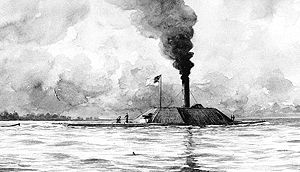 A drawing ofAlbemarle
| |
| History | |
|---|---|
| Name | Albemarle |
| Namesake | Albemarle Sound |
| Ordered | 16 April 1862 |
| Laid down | January 1863 |
| Commissioned | 17 April 1864 |
| Fate | 27 October 1864 sunk byspar torpedo,captured, raised, and sold |
| General characteristics | |
| Displacement | 376 tons |
| Length | 158 ft (48 m) |
| Beam | 35.4 ft (10.8 m) |
| Draught | 9 ft (2.7 m) |
| Propulsion | Steam |
| Speed | 4 knots (7.4 km/h; 4.6 mph) |
| Range | 120 miles, 193 km |
| Complement | 150 officers and men |
| Armament | two 6.4Brookedouble-banded rifles |
CSSAlbemarlewas a steam-poweredcasemate ironcladramof theConfederate Navy(and later the secondAlbemarleof theUnited States Navy), named for anestuaryinNorth Carolinawhich was named forGeneralGeorge Monck,the firstDuke of Albemarleand one of the original CarolinaLords Proprietor.
Construction
[edit]On 16 April 1862, the Confederate Navy Department, enthusiastic about the offensive potential of armored rams following the victory of their first ironclad ramCSSVirginia(the rebuilt USSMerrimack) over the wooden-hulledUnionblockadersinHampton Roads,Virginia, signed a contract with nineteen-year-old detached Confederate LieutenantGilbert ElliottofElizabeth City, North Carolina;he was to oversee the construction of a smaller but still powerful gunboat to destroy the Union warships in the North Carolina sounds. These men-of-war had enabled Union troops to hold strategic positions that controlled eastern North Carolina.
Since the terms of the agreement gave Elliott freedom to select an appropriate place to build the ram, he established a primitive shipyard, with the assistance of plantation owner Peter Smith, in a cornfield up theRoanoke Riverat a place called Edward's Ferry, near modernScotland Neck, North Carolina;Smith was appointed the superintendent of construction. There, the water was too shallow to permit the approach of Uniongunboatsthat otherwise would have destroyed the ironclad while still on itsways.Using detailed sketches provided by Elliott, the Confederate Navy's Chief ConstructorJohn L. Porterfinalized the gunboat's design, giving the ram an armoredcasematewith eight sloping, 30-degree angle sides. Within this thick-walled bunker were two 6.4-inch (160 mm) Brooke pivot rifles, one forward, the other aft, each capable of firing from three different fixed positions. Both cannons were protected on all sides behind six exterior-mounted, heavy iron shutters. The ram was propelled by twin 3-bladed screw propellers powered by two steam engines, each of 200 hp (150 kW), and built by Elliott.

Construction of the ironclad began in January 1863 and continued on during the next year. Word of the gunboat reached the Union naval officers stationed in the region, raising an alarm. They appealed to theWar Departmentfor an overland expedition to destroy the ship, to be christenedAlbemarleafter the body of water into which the Roanoke emptied, but theUnion Armynever felt it could spare the troops needed to carry out such a mission; it was a decision that would prove to be very short-sighted.
Ordnance and projectiles
[edit]Albemarlewas equipped with two 6.4-inch (160 mm)Brookerifled cannon(similar to aParrott rifle); each double-banded cannon weighed more than 12,000 pounds (5,400 kg) with its pivot carriage and other attached hardware. Both cannons were positioned along the ironclad's center-line in the armored casemate, one forward, the other aft. Thefield of firefor both pivot rifles was 180-degrees, fromporttostarboard:each cannon could fire from one of three gun ports, allowingAlbemarleto deliver a two cannonbroadside.Albemarle'sprojectilesconsisted of explosive shells, anti-personnelcanister shot,grapeshot,and blunt-nosed, solid wrought iron "bolts" for use against Union armored ships. These were an early attempt atarmor-piercing shot;solid iron like a typicalsolid shot,but elongated rather than spherical, giving far more weight for an equal frontal area than a traditional round ball, and thus greater penetration. Such projectiles could not be effectively fired from a traditionalsmoothborenaval gun, as the lack of stability would cause the shot to tumble in flight.
Service on the Roanoke River
[edit]In April 1864 the newly commissioned Confederate States SteamerAlbemarle,under the command ofCaptainJames W. Cooke,got underway down-river towardPlymouth, North Carolina;its mission was to clear the river of all Union vessels so thatGeneralRobert F. Hoke's troops could storm the forts located there. She anchored about three miles (5 km) above the town, and the pilot, John Lock, set off with two seamen in a small boat to takesoundings.The river was high and they discovered ten feet of water over the obstructions that the Union forces had placed in the Thoroughfare Gap. Captain Cooke immediately ordered steam and, by keeping to the middle of the channel, they passed safely over the obstructions. The ironclad's armor protected them from the Union guns of the forts at Warren's Neck and Boyle's Mill.
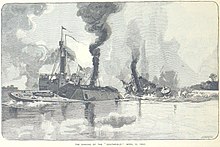
However, twopaddle steamers,USSMiamiandUSSSouthfield,lashed together withsparsand chains, approached from up-river, attempting to pass on either side ofAlbemarlein order to trap her between them. Captain Cooke turned heavily tostarboard,getting outboard ofSouthfield,but running dangerously close to the southern shore. Turning back sharply into the river, he rammed the Union sidewheeler, driving her under;Albemarle's ram became trapped inSouthfield's hull from the force of the blow, and her bow was pulled under as well. AsSouthfieldsank, she rolled over before settling on the riverbed; this action released thedeath gripthat held the new Confederate ram.
Miamifired a shell intoAlbemarleat point-blank range while she was trapped by the wreck ofSouthfield,but the shell rebounded offAlbemarle's sloping iron armor and exploded onMiami,killing her commanding officer, CaptainCharles W. Flusser.Miami's crew attempted to boardAlbemarleto capture her but were soon driven back by heavy musket fire;Miamithen steered clear of the ironclad and escaped into Albemarle Sound.
With the river now clear of Union ships, and with the assistance ofAlbemarle's rifled cannon, General Hoke attacked and took Plymouth and the nearby forts.
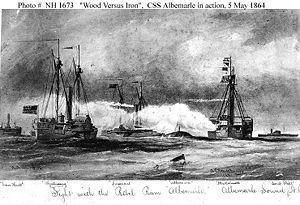
On May 5AlbemarleandCSSBombshell,a captured steamer, were escorting the troop-ladenCSSCotton Plantdown theRoanoke River;they encountered a flotilla of eight Union warships, including USSMiami,USSMattabesett,USSSassacus,andUSSWyalusing,in what would become known as theBattle of Albemarle Sound.All four of the listed ships combined mounted more than sixty cannons.Albemarleopened fire first, wounding six men working one ofMattabesett's two 100-pounderParrott rifles,and then attempted to ram her, but thesidewheelermanaged to round the ironclad's armored bow. She was closely followed bySassacus,which then fired a broadside of solid 9 in (229 mm) and 100-pound shot, all of which bounced offAlbemarle's casemate armor. However,Bombshell,being a softer target, was hulled by each heavy shot fromSassucus's broadside and was quickly captured by Union forces, following her surrender.

Lieutenant CommanderFrancis Asbury RoeofSassucus,seeingAlbemarleat a range of about 400 yards (370 m), decided to ram. The Union ship struck the Confederate ironclad full and square, broadside-on, shattering the timbers of her own bow, twisting off her own bronze ram in the process, and jamming both ships together. WithSassucus's hull almost touching the end of the ram's Brooke rifle,Albemarle's gun crew quickly fired two point-blank rifled shells, one of them puncturingSassucus's boilers; though live steam was roaring through the ship, she was able to break away and drift out of range.Miamifirst tried to use herspar torpedoand then to tangle the Confederate ram's screw propellers and rudder with aseine net,but neither ploy succeeded. More than 500 shells were fired atAlbemarleduring the battle; with visible battle damage to hersmokestackand other areas on the ironclad, she steamed back up the Roanoke, soon mooring at Plymouth.
Sinking
[edit]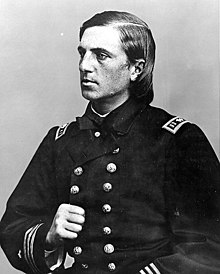
Albemarlesuccessfully dominated the Roanoke and the approaches to Plymouth through the summer of 1864. By autumn the U. S. government decided that the situation should be studied to determine if something could be done: The U. S. Navy considered various ways to destroyAlbemarle,including two plans submitted by LieutenantWilliam B. Cushing;they finally approved one of his plans, authorizing him to locate two smallsteam launchesthat might be fitted withspar torpedoes.Cushing discovered two 30-foot (9.1 m) picket boats under construction in New York and acquired them for his mission [some accounts have them as 45 to 47 feet (14 m)]. On each he mounted aDahlgren12-pounderhowitzerand a 14-foot (4.3 m) spar projecting into the water from its bow. One of the boats was lost at sea during the voyage from New York toNorfolk, Virginia,but the other arrived safely with its crew of seven officers and men at the mouth of the Roanoke. There, the steam launch's spar was fitted with a lanyard-detonated torpedo.
On the night of October 27 and 28, 1864, Cushing and his team began working their way upriver. A small cutter accompanied them, its crew having the task of preventing interference by the Confederate sentries stationed on a schooner anchored to the wreck ofSouthfield;both boats, under the cover of darkness, slipped past the schooner undetected. So Cushing decided to use all twenty-two of his men and the element of surprise to captureAlbemarle.

As they approached the Confederate docks their luck turned, and they were spotted in the dark. They came under heavy rifle and pistol fire from both the shore and aboardAlbemarle.As they closed with the ironclad, they quickly discovered she was defended against approach by floatinglog booms.The logs, however, had been in the water for many months and were covered with heavy slime. The steam launch rode up and then over them without difficulty; with her spar fully against the ironclad's hull, Cushing stood up in the bow and pulled the lanyard, detonating the torpedo's explosive charge.
The explosion threw Cushing and his men overboard into the water; Cushing then stripped off most of his uniform and swam to shore, where he hid undercover until daylight, avoiding the hastily organized Confederate search parties. The next afternoon, he was finally able to steal a smallskiffand began slowly paddling, using his hands and arms as oars, down-river to rejoin Union forces at the river's mouth. Cushing's long journey was quite perilous and he was nearly captured and almost drowned before finally reaching safety, totally exhausted by his ordeal; he was hailed a national hero of the Union cause for his daring exploits. Of the other men in Cushing's launch, one man, Seaman Edward Houghton, also escaped, two others [A.M.M. John Woodman and 1/C fireman Samuel Higgins] were drowned following the explosion, and the remaining eleven were captured.[1]
Cushing's daringcommandoraid blew a hole inAlbemarle's hull at the waterline "big enough to drive a wagon in." She sank immediately in the six feet of water below herkeel,settling into the heavy river bottom mud, leaving the upper casemate mostly dry and the ship's largeStainless Bannerensign flying from theflagstaffat the rear of the casemate's upper deck. Confederate commander Alexander F. Warley, who had been appointed as her captain about a month earlier, later salvaged both ofAlbemarle's rifled cannon and shells and used them to defend Plymouth against subsequent Union attack.
Lieutenant Cushing's successful effort to neutralize CSSAlbemarleis honored by theU.S. Navywith abattle staron the Civil Warcampaign streamer.
Raising and later service
[edit]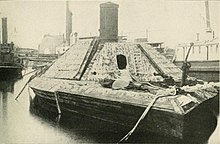
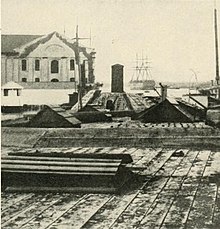
After the fall of Plymouth, the U. S. Navy raised and temporarily hull-patched the Confederate ram. Near the end of the war, the Union gunboatUSSCerestowedAlbemarleto theNorfolk Navy Yard,where she arrived on 27 April 1865. On 7 June orders were issued to repair her hull, and she entereddry docksoon thereafter. The work was completed on 14 August 1865. Two weeks later, the ironclad was judged condemned by aWashington, D.C.prize court.
She saw no active naval service after being placed in ordinary at Norfolk, where she remained until she was finally sold atpublic auctionon 15 October 1867 to J. N. Leonard and Company. She was probablyscrappedforsalvage.One of her 6.4-inch (160 mm) double-bandedBrookerifled cannon is on display at the Headquarters of the Commander U. S.Fleet Forces Commandat theNorfolk, Virginia,naval base. Her smokestack is on display at theMuseum of the AlbemarleinElizabeth City, North Carolina.Her bell is on display at the Port o' Plymouth Museum in Plymouth, North Carolina.[2]
Prize Court Adjudication[3]
| Date | Ship Type | Prize Name | Gross Proceeds | Costs and Expenses | Amount for Distribution | Where Adjudicated | Sent to 4th Auditor for Distribution | Vessels Entitled to Share |
|---|---|---|---|---|---|---|---|---|
| Ram | Albemarle | $79,944.00 | $2,645.30 | $77,298.70 | Washington | 28 Aug 1865 | Lieutenant Commander Cushing and party |
Replica
[edit]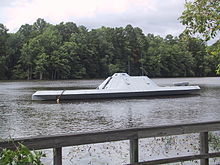

A 3/8 scale 63-foot (19 m) replica ofAlbemarlehas been at anchor near the Port O' Plymouth Museum inPlymouth, North Carolinasince April 2002. The replica is self-powered and capable of sailing on the river. Each year, the replica takes to the water during Living History Weekend in the last weekend of April.[4][5]
See also
[edit]Notes
[edit]- ^"Battles and Leaders of the Civil War" Vol IV pp.641. Lt Cushing's own account can be found in this reference source "The Destruction of the" Albemarle ".pp.634-640]
- ^"The Port o' Plymouth Museum – Washington County Historical Society".
- ^Porter,Naval History,p. 834
- ^"CSS Albemarle".fortbranchcivilwarsite.Retrieved15 March2013.
- ^"The Chronicles of an Ironclad".Archived fromthe originalon 2013-02-27.Retrieved15 March2013.
References
[edit] This article incorporates text from thepublic domainDictionary of American Naval Fighting Ships.
This article incorporates text from thepublic domainDictionary of American Naval Fighting Ships.- Bisbee, Saxon T. (2018).Engines of Rebellion: Confederate Ironclads and Steam Engineering in the American Civil War.Tuscaloosa, Alabama: University of Alabama Press.ISBN978-0-81731-986-1.
- "CSSAlbemarle".cronab.demon.co.uk.Maritime History. Archived fromthe originalon March 8, 2005.RetrievedMarch 8,2005.
- Canney, Donald L. (2015).The Confederate Steam Navy 1861-1865.Atglen, Pennsylvania: Schiffer Publishing.ISBN978-0-7643-4824-2.
- Cushing, William B.(1888),"The Destruction of theAlbemarle",The Century Magazine,The Career of the Confederate RamAlbemarle,XXXVI:386–393,OCLC21247159
- Edwards, E. M. H. (1898).Commander William Barker Cushing, of the United States Navy.London & New York: F. Tennyson Neely Publisher.hdl:2027/hvd.hx4mfu.
- Elliot, Gilbert (1888),"Her Construction and Service",The Century Magazine,The Career of the Confederate RamAlbemarle,XXXVI:374–380,OCLC21247159
- Elliott, Robert G. (1994).Ironclad of the Roanoke: Gilbert Elliott'sAlbemarle.Shippensburg, Pennsylvania: White Mane Publishing.ISBN0-942597-63-X.
- Holden, Edgar (1888),"TheAlbemarleand theSassacu:An Attempt to Run Down an Iron-Clad with a Wooden Ship ",The Century Magazine,The Career of the Confederate Ram "Albemarle",XXXVI:380–392,OCLC21247159
- Hinds, John W. (2002).The Hunt for theAlbemarle:Anatomy of a Gunboat War.Shippensburg, PA: Burd Street Press.ISBN9781572492165.OCLC606812824.
- Madaus, H. Michael (1986),"Rebel Flags Afloat: A Survey of the Surviving Flags of the Confederate States Navy, Revenue Service, and Merchant Marine",The Flag Bulletin, #115,25(1–2): 79,ISSN0015-3370,OCLC16908931
- Porter, David Dixon(1886).The Naval History of the Civil War.New York, NY: The Sherman Publishing Company.OCLC280729.
- Roske, Ralph; Van Doren, Charles (1995).Lincoln's Commando: The Biography of Commander W. B. Cushing, USN(Revised and Expanded ed.). Annapolis, Maryland: Naval Institute Press.ISBN9781557507372.
- Schneller, Robert J. Jr. (2004).Cushing: Civil War SEAL.Brassey's Military Profiles. London: Brassey's.ISBN9781574886962.
- Still, William N. Jr. (1985) [1971].Iron Afloat: The Story of the Confederate Armorclads.Columbia, SC: University of South Carolina Press.hdl:10079/bibid/5349504.ISBN9780872496163.
- Silverstone, Paul H. (2006).Civil War Navies 1855–1883.The U.S. Navy Warship Series. New York: Routledge.ISBN9781138991354.OCLC949751895.
- Silverstone, Paul H. (1984).Directory of the World's Capital Ships.New York: Hippocrene Books.ISBN0-88254-979-0.
- Warley, A.P., CAPT CSN (1888),"The Destruction of theAlbemarle",The Century Magazine,The Career of the Confederate RamAlbemarle,XXXVI:393–394,OCLC21247159
{{citation}}:CS1 maint: multiple names: authors list (link)
External links
[edit]- Ironclad warships of the Confederate States Navy
- Ships built in North Carolina
- 1864 ships
- Shipwrecks of the American Civil War
- Shipwrecks in rivers
- Ships captured by the United States Navy from the Confederate States Navy
- Maritime incidents in October 1864
- Raids of the American Civil War
- George Monck, 1st Duke of Albemarle
